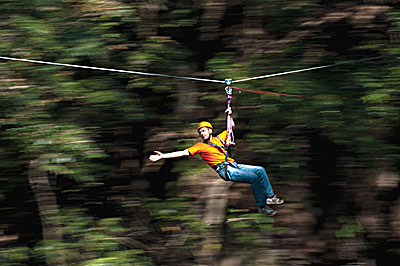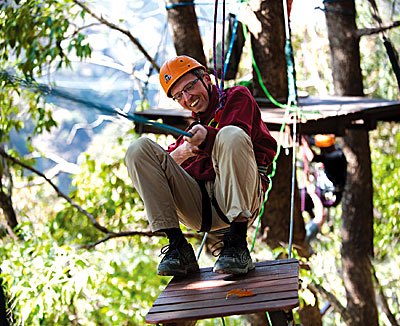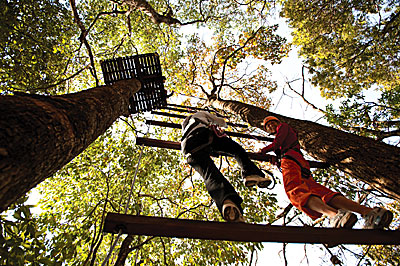Have you ever wondered what it would be like to be Tarzan, swinging high up in the trees? Or how monkeys feel when they hover high above you on your visit to Swayambhu? Well, if you are interested in getting some fun high up in the forest canopy, just hop on a bus and go to The Last Resort, where Nepal's first high rope course has opened.
With eight challenging crossings reaching up to nine metres into the trees, this high rope course offers a new kind of adventure sports and team building exercise in Nepal.
"High Ropes is the brand name for a high wire forest adventure that challenges your personal boundaries, encourages teamwork and builds confidence," says Sam Voolstra, marketing director of The Last Resort.
For the launch of this new adventure 12 people from Nepal and abroad met up and put their bodies and minds into the capable hands of the The Last Resort high wire staff, which is entirely Nepali.
"I felt completely and utterly safe at all times as we were always on a rope. The stations were pretty challenging but it was good to do as I felt so much better afterwards," said Nonna Lamponen, a participant from Finland.
The high rope course, which has enjoyed huge popularity in Europe over the past few years, was designed and built by Austrian Alex Schuchter together with The Last Resort crew.
Modern rope courses were first designed by French naval officer George Hebert 100 years ago as a method of physical education with the aim of developing the physical, morale, and 'virile' qualities in an outdoor environment. However, the main purpose of such a high rope course is not necessarily the physical challenge or the adventure, but the team building exercise.
"Learning through experience has never been more relevant to organisations and individuals as the challenges we face are increasingly demanding, complex and often unpredictable. With the global economic crisis employees need to be motivated," says Voolstra.
"I would actually want to see politicians do it, especially from two different parties," says Mickey Mohan from Kathmandu half-jokingly.
A maximum of 12 people, who are divided into pairs, can join one session, which takes between 2 and 3 hours, and even though the team is always nearby, the participants have to rely on each other during the exercise.
"It really made me realise how important it is to trust another person," said Maske, who took part in the first session.
For some, however, it was more of a physical test as the first ladder (named 'Hillary Steps') seemed to be quite demanding for some participants. "I think the first station could be a challenge for someone who is not very physical," Maskey continued. "But with the help of the team everybody will get up."
However, no one can ever get stuck high up in the trees as participants can be lowered down from any station such as 'Helicopter Rescue', 'Mountain Flight', 'Bagmati River Crossing' and 'Nepali Taxis'.
Billi Bierling in Sindhupalchok
Specifications
Maximum number per session: 12
Maximum number per day: 36
Minimum height: 5'2"
Minimum age: 12
Special introductory rate, applicable till the end of May 2009:
Rs 2,000 for Nepalis, Rs 3,000 for foreigners (lunch included, not transport)
 ALL PICS: ALEX TREADWAY |
 |
 |
 |
 |


